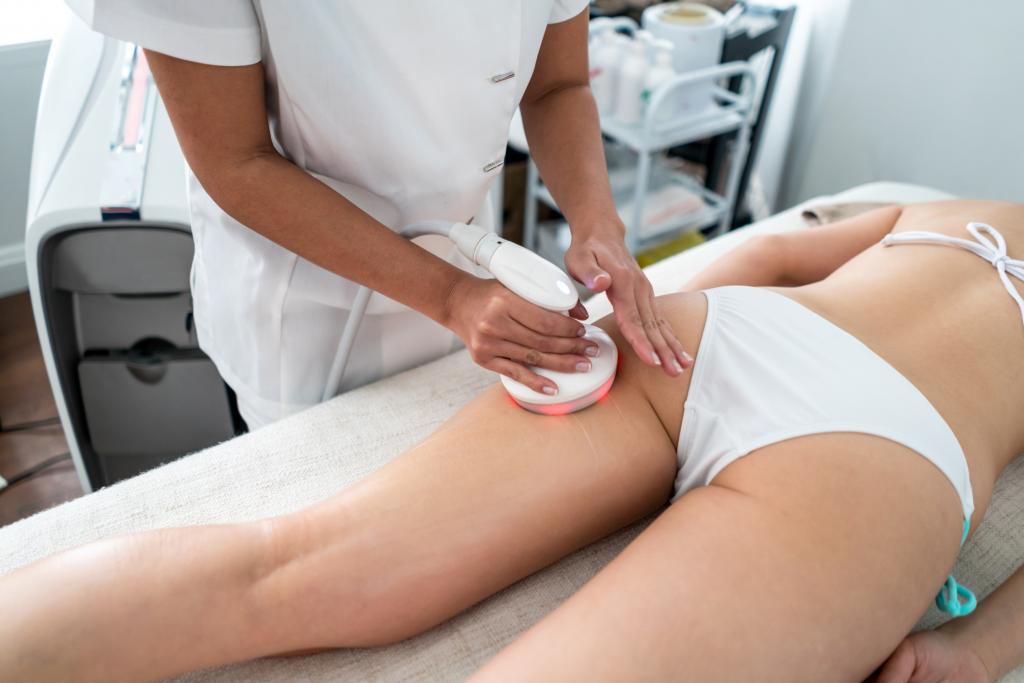Cellulite is a frustrating fact of life. Everyone gets cellulite – both men and women are susceptible to it, but 80 to 90 percent of women live with cellulite according to Medical News Today¹.
However, you don’t have to fight cellulite forever. There are ways to treat it, and some of these treatments can get you the smooth results you desire. Here’s everything you need to know about reducing cellulite and improving skin texture.
 The Causes of Cellulite
The Causes of Cellulite
In order to tackle the appearance of cellulite on your skin, you’ll need to know what causes it. And unfortunately, the jury is still out when it comes to what exactly creates the bumpy, textured appearance of cellulite on the body.
But medical professionals do know how cellulite forms. According to the American Board of Cosmetic Surgery², cellulite forms when fibrous bands connecting skin to muscle tighten or break down. This causes the layer fat underneath the skin to push upward, puckering the skin and creating that lumpy texture.
While it might seem like an excess of fat ultimately causes cellulite, medical professionals aren’t sure that’s the root cause. As the American Board of Cosmetic Surgery³ notes, individuals of all weights and health levels, including very lean individuals, get cellulite. Instead, it’s believed that a combination of different factors make cellulite more likely to appear.
Medical News Today⁴ reports that suspected causes of cellulite include the following:
- Hormonal factors, including the production of estrogen, insulin, noradrenaline, and prolactin.
- Lower circulation.
- Lower collagen production.
- Genetic factors, like metabolism speed, the amount of fat under the skin, and circulatory levels.
- Diet and lifestyle factors, like eating too much fat and too many carbohydrates or staying in one position for long periods of time.
Because any of these factors can affect the odds of cellulite appearing, it’s hard to determine exactly where cellulite originates from. This means that treating cellulite should address these potential causes, as well as what’s happening under your skin, in order to improve the skin’s appearance.
Treatment Options
Treating cellulite is a tough task, and if you’ve tried to treat your cellulite on your own at home, you’ve likely discovered that many treatment options aren’t effective. That’s because, as the American Board of Cosmetic Surgery⁵ writes, there is no permanent treatment for cellulite.
However, just because there’s no permanent treatment doesn’t mean there aren’t ways to reduce the appearance of cellulite. You’ll just need to make sure to remember that no treatment will entirely eliminate cellulite, and that it will likely reappear.
The most effective treatment options for reducing the appearance of cellulite are cosmetic procedures that can be performed by a dermatologist or a cosmetic surgeon. The following are some of the most popular and most successful options for addressing cellulite.
Laser Treatment
Laser treatments for cellulite, which are also commonly called laser cellulite reduction or Cellulaze, can be performed by cosmetic surgeons. During these treatments, a laser probe is inserted beneath the skin and heats up the tissue. This helps reduce fat, stimulates collagen production, and improves the skin’s texture and elasticity, according to the American Board of Cosmetic Surgery⁶.
With laser treatment, you’ll need only local anesthesia and have minimal downtime of just one or two days. The effects of this treatment can last as long as one year, and you’ll typically need just one treatment session.
Mechanical Treatment
Mechanical treatments, known by the FDA approved brand name Cellfina, use an automated mechanism to reduce cellulite. According to the American Board of Cosmetic Surgery⁷, Cellfina works to release the tightened connectors between the skin and muscles with a tiny, thin blade and small incisions. Cellfina only requires local anesthesia, and it allows doctors to get very up close to cellulite in order to reduce its appearance.
Cellfina is one of the most effective cellulite treatments available right now. It lasts for as long as three years, and there’s a noticeable improvement within just a few days of the treatment. You may experience some bruising and soreness after this mechanical treatment, but the side effects are short-lived.
Non-Laser Treatments
There are other treatments for cellulite that aren’t invasive at all. These non-laser treatments work in a few different ways – they heat the skin, use radio and light frequencies, and aim to stimulate collagen production or reduce fat to lessen the appearance of cellulite.
Non-laser treatments include:
- VelaShape, which uses radiofrequency and infrared light
- Venus Freeze, which uses radiofrequency and pulsed electro-magnetic fields
- ThermiSmooth Body, which uses radiofrequency
- Zimmer Z Wave, which is a form of radial pulse therapy
These non-laser forms of treatment deliver their unique energy form through the skin, which makes them noninvasive. You can receive the treatments with no downtime, but you will need a series of treatment sessions for these options.
What Treating Cellulite Costs
While there are quite a few ways to treat cellulite and reduce its appearance, every treatment does come at a cost. And having your cellulite treated in a dermatologist’s or cosmetic surgeon’s office can make these treatments pricey.
You can expect to pay between a few hundred dollars and a few thousand dollars for effective and lasting cellulite treatment. According to Real Simple⁸, non-laser treatments like those using radiofrequency typically cost between $300 and $500 per session – and you’ll likely need a couple of sessions, depending on the specific type of treatment. Laser treatments like Cellulaze can run patients between $2,500 and $3,000 per area.
If you’re interested in reducing the appearance of cellulite and achieving smoother, more flawless-looking skin, there are plenty of treatment options you can consider. But before you settle on a treatment option or a price, make sure you check out all of your options. You can speak with or visit dermatologists and cosmetic surgeons for a free consultation. And these free consultations allow you to learn more without spending a single cent.
Make sure to schedule a free consultation so you can do your research and learn which type of cellulite treatment is the best option for you.
